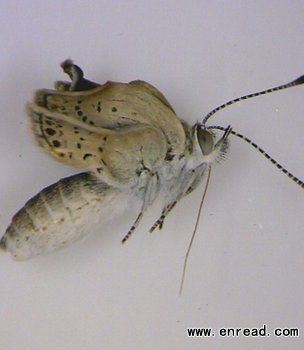| ||||||||||||||||||||||||||||||||||||||||||||||||||||||||||||||||
|
日本科学家研究发现,福岛核事故之后,由于受到放射性物质的影响,日本的蝴蝶品种出现了翅膀变小、眼睛发育不规则等明显的变异现象。
 mutation1 rates were much higher among butterfly collected near Fukushima" style="cursor:pointer" onclick="window.open('/upimg/allimg/120818/1_120818034920_1.jpg')" /> mutation1 rates were much higher among butterfly collected near Fukushima" style="cursor:pointer" onclick="window.open('/upimg/allimg/120818/1_120818034920_1.jpg')" />The study found that mutation rates were much higher among butterfly collected near Fukushima Exposure to radioactive material released into the environment has caused mutations in butterflies found in Japan, a study suggests.
Scientists found an increase in leg, antennae2 and wing shape mutations among butterflies collected following the 2011 Fukushima accident.
The link between the mutations and the radioactive material was shown by laboratory experiments, they report.
The work has been published in the journal Scientific Reports.
Two months after the Fukushima Daiichi nuclear power plant accident in March 2011, a team of Japanese researchers collected 144 adult pale grass blue (Zizeeria maha) butterflies from 10 locations in Japan, including the Fukushima area.
Unexpected results
By comparing mutations found on the butterflies collected from the different sites, the team found that areas with greater amounts of radiation in the environment were home to butterflies with much smaller wings and irregularly developed eyes.
"It has been believed that insects are very resistant4 to radiation," said lead researcher Joji Otaki from the University of the Ryukyus, Okinawa.
"In that sense, our results were unexpected," he told BBC News.
The Japanese researchers have been studying the species for more than a decade Prof Otaki's team then bred these butterflies within labs 1,750km (1,090 miles) away from the accident, where artificial radiation could hardly be detected.
It was by breeding these butterflies that they began noticing a suite5 of abnormalities that hadn't been seen in the previous generation - that collected from Fukushima - such as malformed antennae, which the insects use to explore their environment and seek out mates.
Six months later, they again collected adults from the 10 sites and found that butterflies from the Fukushima area showed a mutation rate more than double that of those found sooner after the accident.
The team concluded that this higher rate of mutation came from eating contaminated food, but also from mutations of the parents' genetic6 material that was passed on to the next generation, even though these mutations were not evident in the previous generations' adult butterflies.
The team of researchers have been studying that particular species butterfly for more than 10 years.
They were considering using the species as an "environmental indicator7" before the Fukushima accident, as previous work had shown it is very sensitive to environmental changes.
"We had reported the real-time field evolution of colour patterns of this butterfly in response to global warming before, and [because] this butterfly is found in artificial environments - such as gardens and public parks - this butterfly can monitor human environments," Prof Otaki said.
But the findings from their new research show that the radionuclides released from the accident were still affecting the development of the animals, even after the residual8 radiation in the environment had decayed.
"This study is important and overwhelming in its implications for both the human and biological communities living in Fukushima," explained University of South Carolina biologist Tim Mousseau, who studies the impacts of radiation on animals and plants in Chernobyl and Fukushima, but was not involved in this research.
"These observations of mutations and morphological abnormalities can only be explained as having resulted from exposure to radioactive contaminants," Dr Mousseau told BBC News.
The findings from the Japanese team are consistent with previous studies that have indicated birds and butterflies are important tools to investigate the long-term impacts of radioactive contaminants in the environment.
点击  收听单词发音 收听单词发音
|
||||||||||||||||||||||||||||||||||||||||||||||||||||||||||||||||
上一篇:泰国某夜总会失火 四人死亡 下一篇:意大利选美禁穿比基尼 |
||||||||||||||||||||||||||||||||||||||||||||||||||||||||||||||||
- 发表评论
-
- 最新评论 进入详细评论页>>



